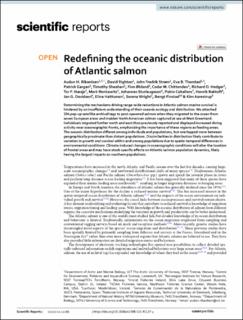| dc.contributor.author | Rikardsen, Audun H. | |
| dc.contributor.author | Righton, David | |
| dc.contributor.author | Strøm, John Fredrik | |
| dc.contributor.author | Thorstad, Eva Bonsak | |
| dc.contributor.author | Gargan, Patrick G. | |
| dc.contributor.author | Sheehan, Timothy F. | |
| dc.contributor.author | Økland, Finn | |
| dc.contributor.author | Chittenden, Cedar | |
| dc.contributor.author | Hedger, Richard David | |
| dc.contributor.author | Næsje, Tor | |
| dc.contributor.author | Renkawitz, Mark | |
| dc.contributor.author | Sturlaugsson, Johannes | |
| dc.contributor.author | Caballero, Pablo | |
| dc.contributor.author | Baktoft, Henrik | |
| dc.contributor.author | Davidsen, Jan Grimsrud | |
| dc.contributor.author | Halttunen, Elina | |
| dc.contributor.author | Wright, Serena | |
| dc.contributor.author | Finstad, Bengt | |
| dc.contributor.author | Aarestrup, Kim | |
| dc.coverage.spatial | Europe, North America, West Greenland | en_US |
| dc.date.accessioned | 2021-06-16T07:52:04Z | |
| dc.date.available | 2021-06-16T07:52:04Z | |
| dc.date.created | 2021-06-15T09:26:13Z | |
| dc.date.issued | 2021 | |
| dc.identifier.issn | 2045-2322 | |
| dc.identifier.uri | https://hdl.handle.net/11250/2759684 | |
| dc.description.abstract | Determining the mechanisms driving range-wide reductions in Atlantic salmon marine survival is hindered by an insufcient understanding of their oceanic ecology and distribution. We attached 204 pop-up satellite archival tags to post-spawned salmon when they migrated to the ocean from seven European areas and maiden North American salmon captured at sea at West Greenland. Individuals migrated further north and east than previously reported and displayed increased diving activity near oceanographic fronts, emphasizing the importance of these regions as feeding areas. The oceanic distribution difered among individuals and populations, but overlapped more between geographically proximate than distant populations. Dissimilarities in distribution likely contribute to variation in growth and survival within and among populations due to spatio-temporal diferences in environmental conditions. Climate-induced changes in oceanographic conditions will alter the location of frontal areas and may have stock-specifc efects on Atlantic salmon population dynamics, likely having the largest impacts on southern populations. | en_US |
| dc.language.iso | eng | en_US |
| dc.rights | Navngivelse 4.0 Internasjonal | * |
| dc.rights.uri | http://creativecommons.org/licenses/by/4.0/deed.no | * |
| dc.subject | atlantic salmon | en_US |
| dc.title | Redefining the oceanic distribution of Atlantic salmon | en_US |
| dc.type | Peer reviewed | en_US |
| dc.type | Journal article | en_US |
| dc.description.version | publishedVersion | en_US |
| dc.rights.holder | © The Author(s) 2021 | en_US |
| dc.subject.nsi | VDP::Zoologiske og botaniske fag: 480 | en_US |
| dc.subject.nsi | VDP::Zoology and botany: 480 | en_US |
| dc.source.volume | 11 | en_US |
| dc.source.journal | Scientific Reports | en_US |
| dc.identifier.doi | 10.1038/s41598-021-91137-y | |
| dc.identifier.cristin | 1915812 | |
| dc.relation.project | Norges forskningsråd: 280308 | en_US |
| dc.relation.project | Andre: Xunta de Galicia and the Icelandic Salmonid Enhancement Fund | en_US |
| dc.relation.project | Norges forskningsråd: 221400 | en_US |
| dc.relation.project | Andre: Tromsø Research Foundation | en_US |
| dc.relation.project | Andre: Greenland Institute of Natural Resources | en_US |
| dc.relation.project | Andre: Denmark’s Center for Wild Salmon | en_US |
| dc.relation.project | Andre: Danish Rod and Net License Fund | en_US |
| dc.relation.project | Andre: Atlantic Salmon Conservation Foundation | en_US |
| dc.relation.project | Andre: UiT | en_US |
| dc.relation.project | Andre: Inland Fisheries Ireland | en_US |
| dc.relation.project | Andre: Alta Laksefskeri Interessentskap | en_US |
| dc.relation.project | Andre: NOAA Fisheries Service (USA) | en_US |
| dc.source.articlenumber | 12266 | en_US |
| cristin.ispublished | true | |
| cristin.fulltext | original | |
| cristin.qualitycode | 1 | |

